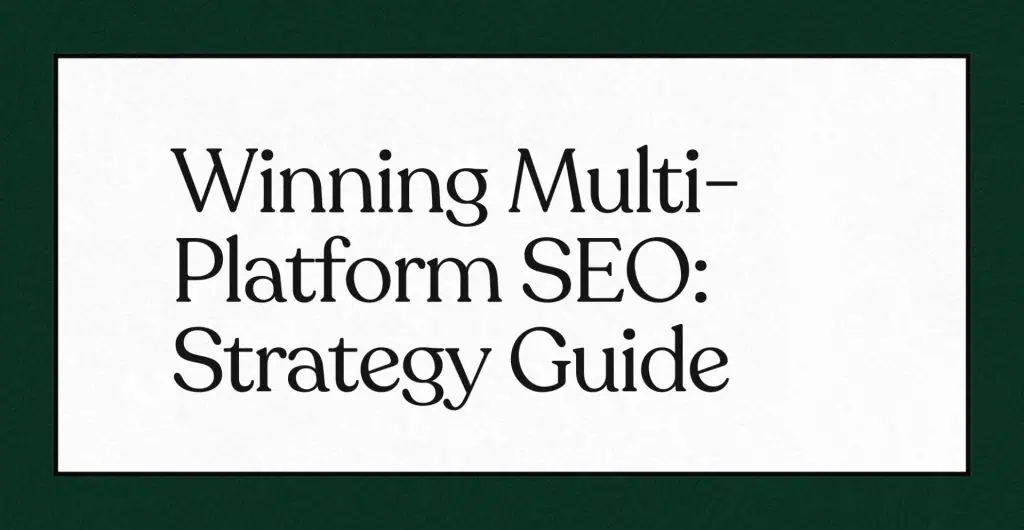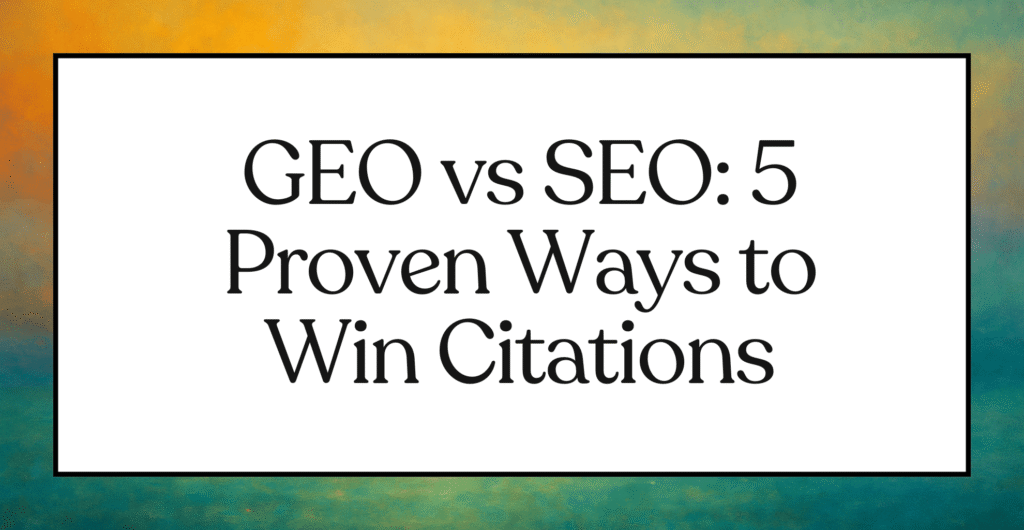Summary
In 2025, relying solely on Google for SEO is no longer sufficient as customer search behavior has fragmented across platforms like TikTok, Amazon, and voice assistants. A multi-platform SEO strategy, which adapts optimization techniques for each specific channel, is now essential for businesses to reach diverse audiences and reduce dependency on a single traffic source. To succeed, companies must create platform-specific content that aligns with user intent, whether it’s for social discovery, e-commerce, or conversational AI queries.
Sarah, a small business owner, spends hours fine-tuning her site for Google. She studies keywords, builds backlinks, and invests in traditional SEO. Her rankings improve, but sales stall. The problem isn’t her dedication. It’s that her ideal buyers are elsewhere, searching on TikTok, comparing products on Amazon, and asking Alexa for recommendations. A Google-only mindset misses all that activity.
This is the reality of 2025. User behavior has splintered across channels, and a multi-platform SEO strategy is now essential to stay visible where customers actually search, scroll, and shop.
What is a Multi-Platform SEO Strategy?
A multi-platform SEO strategy extends beyond optimizing for Google or Bing. It positions a brand across all major discovery channels:
- Social platforms like TikTok, Instagram, and LinkedIn
- Marketplaces like Amazon
- Video platforms like YouTube
- Local directories and app stores
- AI-powered interfaces such as ChatGPT Search or voice assistants
The principles of SEO remain—clear search intent, optimized content, strong user experience, and authority building—but they are adapted to each channel’s algorithm and content format. Done well, multi-platform SEO creates a consistent and visible brand presence across the digital ecosystem.
Why Multi-Platform SEO is Essential in 2025
Diverse Audience Reach
Every platform attracts different segments. TikTok skews young, LinkedIn gathers professionals, Amazon captures ready-to-buy shoppers, and voice search addresses quick, often local questions. A multi-platform SEO approach ensures visibility across all of them.
Evolving Search Behaviors
Search no longer starts in one box. Users look for tutorials on TikTok, product inspiration on Instagram, and direct answers from AI assistants. A strategy that ignores these entry points loses large portions of potential demand.
Risk Reduction
Dependence on Google alone is fragile. One algorithm change can cut traffic dramatically. Multi-platform SEO diversifies discovery sources, stabilizing visibility and sales.
Competitive Edge
While many businesses still focus narrowly, adopting multi-platform SEO early allows brands to capture audiences before competitors saturate those spaces.
Stronger Marketing Alignment
By spreading optimization across channels, businesses gain a sharper understanding of audience segments and behaviors. That knowledge feeds back into better content, smarter targeting, and stronger engagement. Social signals, brand mentions, and user activity across platforms also reinforce traditional search performance.
Building Authority
Visibility across multiple touchpoints builds credibility. When users encounter a brand consistently—whether in a TikTok trend, an Amazon listing, or a voice assistant answer—it reinforces trust and encourages direct searches and backlinks. Multi-platform SEO not only widens reach but strengthens brand authority.
The web in 2025 is fragmented but full of opportunity. A narrow focus on Google misses too much. Businesses that embrace multi-platform SEO will secure visibility, resilience, and trust across every channel that matters.
2025 Digital Marketing Trends Demanding Multi-Platform SEO
The urgency for adopting a multi-platform SEO strategy is clear in 2025. Search habits are evolving quickly, and user discovery no longer happens in a single channel. Businesses that adapt will stay visible; those that rely only on Google will see declining reach.
The Rise of AI Overviews and AI Search Engines
Google’s AI Overviews and new AI-driven search engines like Perplexity or ChatGPT Search now provide answers directly on results pages. That means fewer clicks to websites and more visibility needed inside the summaries. Content featured in YouTube, LinkedIn, or other platforms is often pulled into these answers, making multi-platform SEO a necessity.
Search Beyond Google
People search everywhere: TikTok, Instagram, Amazon, Reddit, and voice assistants. Each platform has unique ranking signals and user expectations. A narrow focus on Google ignores massive search volumes elsewhere. A multi-platform SEO approach ensures brand visibility across all channels where discovery happens.
TikTok and Instagram now serve as discovery hubs. Users look up reviews, tutorials, and trends directly in these apps. Dedicated optimization for social platforms—profiles, captions, hashtags—is no longer optional. Brands applying multi-platform SEO here capture younger audiences where they actually search.
Growth of Voice and Visual Search
Voice queries through smart speakers and mobile assistants grow steadily, while visual search tools like Google Lens gain adoption. Conversational phrasing, local intent, and image optimization become part of multi-platform SEO strategies, extending visibility beyond text-based search.
Google displays Reddit threads, YouTube content, and shopping results inside search. Amazon integrates discovery-style feeds. Social platforms point back to commerce. A siloed tactic fails here. The strength of multi-platform SEO lies in using content across formats so visibility multiplies from one channel to another.
User-First Content and Experience
Algorithm updates reward helpful, authentic, well-presented content. Thin or generic AI-generated material won’t sustain rankings. A successful multi-platform SEO strategy centers on authoritative, practical content adapted for each channel—fast-loading web pages, engaging TikToks, structured product listings, or professional LinkedIn posts.
Mastering the Feed: Actionable SEO for TikTok in 2025
TikTok has exploded beyond entertainment, becoming a vital search and discovery engine, particularly for younger audiences. Optimizing your presence here is crucial for any multi-platform SEO strategy. Success requires understanding its unique algorithm, which prioritizes engagement, relevance, and user interaction.
Here’s a step-by-step guide to TikTok SEO best practices for 2025:
1. Strategic TikTok Keyword Research:
- Leverage the TikTok Search Bar: This is your primary tool. Type in broad keywords related to your niche and observe the auto-suggestions – these reflect real user searches. Explore related videos and hashtags shown in results.
- Employ the “Alphabet Soup” Method: Enter your core keyword followed by each letter (e.g., “skincare a,” “skincare b”) to uncover longer-tail variations.
- Analyze Competitors & Niche Leaders: Observe the keywords and hashtags used in top-performing content within your niche. What topics resonate? What formats work?
- Think Long-Tail & Conversational: Focus on specific phrases and questions users might ask (e.g., “5-minute makeup tutorial for beginners” instead of just “makeup”). These often have lower volume but higher intent.
- Use TikTok’s Keyword Insights Tool (Ads): While designed for advertising, this tool offers valuable organic insights into keyword performance, related terms, and trending hashtags based on successful ad data.
- Explore External Tools (with Context): Tools like Semrush or Google Trends can provide broader topic ideas, but always validate their relevance directly within TikTok.
2. Effective Keyword Placement:
- Profile Optimization: Include core keywords naturally in your username (if possible) and bio. Use relevant hashtags in your bio as well. Ensure your bio clearly states what your account is about.
- Video Captions: Write engaging captions that incorporate 3-5 highly relevant keywords naturally. Place important keywords upfront. Avoid keyword stuffing; relevance is key. TikTok allows 2,200 characters, but concise, focused captions often perform better.
- On-Screen Text Overlays: Integrate keywords directly into the text appearing on your video. This boosts search relevance and scannability. Prioritize placing text early in the video, using larger, centered fonts with good contrast.
- Spoken Keywords (Voiceover/Audio): Mention your main keyword(s) verbally within the video, ideally near the beginning. TikTok transcribes audio, and the algorithm reads these captions.
- Hashtags: Use a strategic mix (see below).
3. Crafting a Winning Hashtag Strategy:
- Balanced Approach: Combine different hashtag types for optimal reach :
- Broad Hashtags: General terms for wider visibility.
- Niche-Specific Hashtags: Target specific communities and interests (e.g., #SmallBusinessTips, #VeganRecipes). Aim for hashtags with under 100k posts for niche targeting.
- Trending Hashtags: Participate in relevant trends to tap into current conversations. Use TikTok’s Creative Center or Discover page to find trends.
- Keyword Hashtags: Include hashtags directly related to your video’s keywords.
- Relevance is Key: Only use hashtags genuinely related to your content.
- Optimal Number: Aim for 3-5 well-chosen hashtags per video; quality over quantity.
4. Optimizing for Engagement (Crucial for the Algorithm):
- High-Quality Content: Use clear, high-resolution video and audio. Good lighting and editing matter.
- Hook Viewers Immediately: Grab attention within the first 2-3 seconds with a compelling visual, question, or bold statement.
- Prioritize Watch Time & Completion Rate: Keep viewers engaged until the end. Structure videos effectively (e.g., start with a question, answer it, tease a final point). Analyze audience retention in analytics.
- Use Trending Sounds & Effects: Incorporate popular audio and effects that align with your brand to boost visibility.
- Encourage Interaction: Explicitly ask viewers to like, comment, share, or save. Use polls, quizzes, or questions in captions. Respond to comments promptly, potentially with video replies.
- Leverage Native Features: Experiment with Duets, Stitches, and Carousels to increase interaction and disrupt the feed.
- Post Consistently: Maintain a regular posting schedule to keep your audience engaged and signal activity to the algorithm.
- Analyze TikTok Analytics: Regularly monitor metrics (views, watch time, completion rate, shares, saves, follower growth, traffic sources, search queries) to understand what resonates and refine your strategy. Identify your best-performing content and replicate successful elements.
By diligently applying these SEO for TikTok techniques, businesses can significantly improve their discoverability and engagement on this increasingly vital platform within their multi-platform SEO strategy.
Amazon SEO Optimization for 2025
For businesses selling products online, Amazon is often not just a channel, but the channel. Optimizing for Amazon’s search algorithm (historically A9, now evolving towards A10) is paramount for product visibility and sales, forming a critical component of any e-commerce multi-platform SEO strategy. Unlike Google, Amazon’s algorithm is laser-focused on one primary goal: driving sales. Therefore, Amazon SEO optimization prioritizes factors directly related to relevance and performance (conversion rates, sales velocity, customer satisfaction). The newer A10 iteration reportedly places even greater emphasis on factors like seller authority, external traffic, and customer engagement.
Here’s a breakdown of optimizing your Amazon listings in 2025:
1. In-Depth Keyword Research for Shoppers:
- Understand Buyer Intent: Focus on keywords shoppers use when ready to buy. Think specific features, benefits, problems solved, and product types.
- Utilize Amazon-Specific Tools: Leverage tools like Helium 10, Jungle Scout, or Sellics designed for Amazon keyword research. These provide insights into search volume, competition, and high-converting terms specific to the platform.
- Analyze Competitor Listings: Examine the keywords used in the titles, bullet points, and descriptions of top-ranking competitors to identify gaps and opportunities. Reverse ASIN lookup tools can be particularly helpful.
- Leverage Amazon’s Data: Use Amazon Brand Analytics (if available) for insights into popular search terms and customer behavior. Pay attention to Amazon’s search bar autocomplete suggestions.
- Mix Keyword Types: Include both broad terms (general traffic) and long-tail keywords (higher purchase intent). Consider common misspellings and variations.
2. Strategic Keyword Placement (Without Stuffing):
- Product Title: This is prime real estate. Include your most important, high-volume, exact-match keywords naturally, ideally near the beginning. Follow Amazon’s style guides and character limits (often ~80 characters visible on mobile). Structure logically: + [Key Feature/Material] + +.
- Bullet Points: Highlight key features and benefits, incorporating relevant keywords naturally. Focus on solving customer problems. Use all available bullet points.
- Product Description: Provide a detailed, engaging overview using keywords contextually. Explain benefits and use cases. Structure for readability (short paragraphs, potentially HTML formatting if allowed).
- Backend Search Terms: Utilize these hidden fields to include relevant keywords, synonyms, long-tail variations, and common misspellings that don’t fit elsewhere. Adhere to byte limits (typically 249 bytes) and avoid repeating words already present in the title or bullets.
- A+ Content / Enhanced Brand Content (EBC): Use these visually rich sections to incorporate keywords within descriptive text and image alt-text (where applicable), enhancing engagement and providing more context for the algorithm.
- Q&A Section: Answer customer questions thoroughly, incorporating relevant keywords naturally in your responses.
3. Visual Optimization: Images and Video :
- High-Resolution Images: Use clear, professional-quality images meeting Amazon’s specs (e.g., 2000×2000 pixels, pure white background for main image). Show the product from multiple angles, highlight key features, and include lifestyle shots demonstrating usage and scale. Ensure zoom functionality works.
- Infographics & Comparison Charts: Use secondary images to visually convey information, benefits, and competitive advantages.
- Video Content: Leverage video (often via A+ Content) for product demonstrations, tutorials, feature highlights, and testimonials. Videos significantly boost engagement and conversion. Aim for concise (15-30 seconds) and informative videos.
4. Leveraging Reviews and Customer Satisfaction:
- Encourage Positive Reviews: Actively request reviews from satisfied customers High ratings and positive sentiment build trust and influence rankings.
- Respond to Feedback: Address both positive and negative reviews promptly and professionally. Resolve issues to demonstrate good customer service.
- Monitor Review Rate: Aim for a healthy review-to-sale ratio (e.g., >3%).
5. Optimizing for A10 Factors (Beyond Keywords):
- Sales Velocity & History: Consistent sales are a powerful ranking signal. Utilize promotions, competitive pricing, and advertising to maintain sales momentum.
- Conversion Rate (CVR): Optimize every element of your listing (title, images, bullets, description, price, reviews, A+ Content) to maximize the percentage of visitors who purchase. Track Unit Session Percentage.
- Click-Through Rate (CTR): Ensure your main image, title, and price are compelling enough to earn clicks from the search results page.
- Seller Authority: Maintain excellent seller metrics: high feedback score, fast shipping times (consider FBA), low return rates, and responsive customer service.
- External Traffic: Drive traffic to your Amazon listings from external sources (social media, blogs, email, Google Ads). Amazon rewards listings that bring in outside customers.
- Pricing: Employ competitive and potentially dynamic pricing strategies.
- Stock Availability: Maintain consistent inventory levels to avoid losing sales and ranking momentum.
Amazon listing optimization is an ongoing process. Regularly monitor performance metrics (sales, CVR, CTR, BSR), analyze competitor strategies, stay updated on algorithm changes, and continuously refine your listings for optimal results.
SEO for Voice Search and AI Assistants in 2025
The rise of smart speakers (Alexa, Google Assistant) and AI-powered conversational interfaces (ChatGPT, Gemini) necessitates optimizing content for spoken queries – a critical aspect of a forward-thinking multi-platform SEO strategy. SEO for voice search and AI assistant SEO differ from traditional SEO because queries are typically longer, more conversational, and often phrased as questions. Users expect direct, concise answers.
Here are key techniques for optimizing your content for discovery via voice and AI in 2025:
1. Target Conversational & Long-Tail Keywords:
- Think Questions: Focus on keywords phrased as questions (“how to,” “what is,” “where can I find,” “best near me”) that mirror natural speech patterns.
- Identify Long-Tail Phrases: Voice searches are inherently longer. Use keyword research tools (like AnswerThePublic, Semrush, Google Keyword Planner) to find these specific, multi-word queries. Analyze “People Also Ask” sections on Google for ideas.
- Natural Language: Write content using natural, conversational language rather than overly technical jargon, mimicking how people actually speak.
2. Structure Content for Featured Snippets & Direct Answers:
- Aim for Position Zero: Voice assistants and AI often pull answers directly from featured snippets (the answer boxes at the top of Google SERPs). Optimizing for these is paramount.
- Provide Concise Answers: Structure content to provide clear, direct answers to specific questions, ideally near the beginning of a section or page. Aim for brevity, often around 30 words, as this is what assistants tend to read aloud.
- Use Formatting: Employ clear headings (H1, H2, H3), bullet points, numbered lists, and tables to structure information logically. This makes it easier for search engines and AI to parse and extract answers.
- Create FAQ Pages/Sections: Dedicate sections or entire pages to Frequently Asked Questions. This directly targets question-based queries common in voice search.
3. Implement Relevant Schema Markup (Structured Data):
- Enhance Understanding: Schema markup provides context to search engines and AI about your content, increasing the likelihood of it being used for voice answers or rich results.
- Use Specific Schema Types: Implement relevant schema like FAQPage for question-and-answer content, HowTo for step-by-step instructions, LocalBusiness for local information, and potentially Speakable schema (though its impact is debated). Tools like AIOSEO or schema generators can help implement this without coding.
4. Optimize for Local Voice Queries:
- Leverage “Near Me” Intent: Many voice searches have local intent (“pizza place near me,” “hardware store open now”).
- Optimize Google Business Profile (GBP): Ensure your GBP listing is complete, accurate, and optimized with correct NAP (Name, Address, Phone number), business hours, services, photos, and reviews.
- Local Keywords: Include location-specific keywords (city, neighborhood, landmarks) in your website content and GBP description.
- NAP Consistency: Maintain consistent business information across all online directories and citations.
- Local Business Schema: Implement LocalBusiness schema markup on your website.
5. Ensure Technical Foundations: Mobile-Friendliness & Speed:
- Mobile-First is Crucial: The vast majority of voice searches happen on mobile devices. Your website must be mobile-friendly, using responsive design that adapts to all screen sizes. Navigation should be simple and touch targets large enough.
- Page Speed Matters: Voice assistants prioritize fast-loading results. Optimize images, minimize code, leverage browser caching, and potentially use a Content Delivery Network to improve site speed. Monitor Core Web Vitals (LCP, FID, CLS).
By incorporating these SEO for voice search and AI assistant SEO techniques, businesses can ensure their content is discoverable and accessible through the increasingly prevalent conversational interfaces shaping the 2025 digital marketing trends.
Cross-Platform SEO Tools for Analysis and Management
Managing a multi-platform SEO strategy effectively requires the right toolkit. While no single tool perfectly covers every platform (TikTok, Amazon, Google, Voice, etc.), several powerful solutions offer features crucial for cross-channel analysis, keyword research, rank tracking, technical audits, and competitor monitoring. Choosing the best cross-platform SEO tools depends on your specific needs, budget, and the platforms you prioritize, especially for SEO for small businesses.
Here’s a look at key tool categories and notable examples for 2025:
1. All-in-One SEO Platforms: These offer broad functionality across various SEO disciplines, often including features relevant to multiple channels.
- Semrush: A market leader known for its extensive keyword database (tracking billions globally), competitor analysis (organic and paid), backlink analysis, site audits, rank tracking, and content marketing tools. Its robust feature set, including social media tracking and market analysis capabilities, makes it valuable for integrating insights across channels. Enterprise plans offer enhanced automation and data handling. Often favored by agencies and those needing comprehensive SEO and PPC data. Integrates with Google Analytics and Search Console.
- Ahrefs: Renowned for its industry-leading backlink index and analysis capabilities. Also strong in keyword research (Keywords Explorer), content analysis (Content Explorer), rank tracking, and site audits. While perhaps less focused on PPC than Semrush, its deep SEO data, particularly for backlinks and content gaps, is highly valued. Considered user-friendly with strong data visualization. Offers enterprise solutions.
- SE Ranking: A comprehensive toolkit often highlighted for its balance of features and affordability, making it a strong contender for agencies and SMEs. Features include accurate rank tracking (including local/maps), keyword research across many countries, competitor analysis (SEO/PPC), backlink checking, website audits, white-label reporting, and content marketing tools. Offers agency-specific features like a lead generator widget.
- Moz Pro: A long-standing player known for its user-friendliness, educational resources, and metrics like Domain Authority. Offers keyword research, backlink analysis, site audits, rank tracking, and competitive analysis tools. Caters to various business sizes, including local SEO features (Moz Local).
- seoClarity: An enterprise-focused platform emphasizing control, automation, and AI-powered insights. Features include real-time site health monitoring (Clarity Grid™), AI content generation/optimization (AI Content Fusion), advanced rank tracking, site audits, and API access. Includes a native generative AI assistant.
2. Specialized Tools: These excel in specific areas, complementing all-in-one platforms or providing focused solutions.
Technical SEO
- Screaming Frog SEO Spider: A powerful desktop crawler for in-depth technical audits, finding broken links, analyzing metadata, discovering duplicate content, and generating sitemaps. Offers an enterprise version.
- Lumar (formerly DeepCrawl): Cloud-based enterprise crawler with scheduled reports and collaboration features.
- Sitebulb: Combines technical audits with visual reports and task management.
Content Optimization & Ideation
- Surfer SEO: Focuses on optimizing content based on top-ranking pages, featuring AI integration for outlines and analysis. Includes keyword research and audit tools.
- Clearscope: AI-driven tool for content optimization, providing detailed insights and grading based on SERP analysis.
- AnswerThePublic: Visualizes questions, prepositions, and comparisons related to keywords, excellent for understanding user intent and finding voice search queries.
- BuzzSumo: Strong for content ideation, finding trending topics, and analyzing content performance across the web.
Local SEO
- BrightLocal: Comprehensive platform for local businesses, offering local rank tracking, citation building/management, review monitoring across many platforms, and GBP auditing.
- Yext: Enterprise-level platform for managing local listings across hundreds of publishers, review monitoring, and creating SEO-optimized local landing pages.
- Local Falcon: Visualizes local map rankings from different geographic points.
Keyword & Trend Research
- Google Keyword Planner: Free tool for keyword ideas and volume estimates (within Google Ads).
- Google Trends: Free tool to explore trending topics and keyword popularity over time and by region.
- Exploding Topics: Identifies rapidly growing topics before they peak.
Website Analytics & Performance
- Google Analytics 4 (GA4): Essential free tool for tracking website traffic, user behavior, conversions, and traffic sources (including organic search from various platforms). Offers cross-platform reporting.
- Google Search Console (GSC): Free tool providing direct data from Google on search performance (queries, clicks, impressions, CTR, position), indexing status, crawl errors, mobile usability, Core Web Vitals, and security issues. Crucial for monitoring Google visibility.
- Hotjar / Microsoft Clarity: Provide user behavior insights like heatmaps and session recordings, complementing quantitative data from GA4. Clarity is free.
3. AI-Driven SEO Tools: AI is increasingly integrated into existing platforms (Semrush Copilot, seoClarity AI, Surfer AI) and powers specialized tools.
- Benefits: AI helps automate repetitive tasks, analyze vast datasets, generate content outlines/ideas, identify optimization opportunities, cluster keywords, and provide predictive insights.
- Examples: Tools like Outranking (outlines), CanIRank (competition analysis), Keyword Insights (clustering), and Diib (monitoring) leverage AI for specific tasks Platforms like SearchAtlas integrate AI across various SEO functions.
Choosing the Right Tools for SMEs
- Start with Free Essentials: Google Analytics 4 and Google Search Console are non-negotiable and free.
- Assess Needs vs. Budget: Do you need deep backlink data (Ahrefs)? Comprehensive keyword/competitor insights (Semrush)? Strong local features (BrightLocal)? Affordable all-in-one (SE Ranking)?. Many platforms offer tiered pricing suitable for small businesses.
- Consider User-Friendliness: Tools like Moz Pro or Mangools are often cited as easier for beginners.
- Leverage Free Trials: Most paid tools offer free trials – use them to evaluate usability and data accuracy before committing.
- Integration: Look for tools that integrate with each other (e.g., platforms integrating with GA4/GSC) to centralize data and streamline workflows.
A combination of an all-in-one platform supplemented by essential free Google tools and potentially a few specialized tools based on priorities often provides the best coverage for managing a multi-platform SEO strategy.
Case Studies in Multi-Platform SEO Strategy
Best practices are useful, but case studies reveal how multi-platform SEO works in real contexts. Each example shows how brands adapt content, structure, and channels to extend reach and achieve measurable results.
OEP previously ran four independent sites for different audiences—businesses, talent, investors, and media. This created fragmented tracking and inconsistent journeys. By consolidating under Orlando.org with segmented subdomains (business.orlando.org, life.orlando.org, etc.), they applied a multi-platform SEO framework internally. Core tactics included audience research, content silos, consistent URL structures, canonical management to avoid duplication, and GA4 for unified analytics. The result was smoother navigation and stronger engagement.
WPI in China: Localization Across Platforms
Worcester Polytechnic Institute needed visibility among Chinese students. Working with Sunrise International, they executed a multi-platform SEO strategy tailored to local habits: a mobile-friendly .cn site, WeChat for content distribution, campaigns on Bilibili and Xiaohongshu, and Baidu-focused SEO. By aligning content with cultural context—alumni interviews, lifestyle videos—they boosted brand awareness and lead generation in key Chinese hubs.
Mercedes-Benz CLA Launch: Integrated Messaging
For the CLA model, Mercedes-Benz combined traditional and digital in a seamless multi-platform SEO campaign. A Super Bowl ad drove attention, while a microsite, social campaigns (#clatakethewheel), Facebook ads, influencer partnerships, and earned coverage extended reach. Coordinated storytelling produced their strongest launch in decades, showing how visibility strengthens when every channel reinforces the same message.
Escape the Room: Local SEO at Scale
Operating across multiple locations, this company needed geo-specific visibility. They built location-focused content, filled keyword gaps through competitor analysis, and maintained backlink growth. The outcome: over 4 million impressions and stronger rankings for local queries. Their multi-platform SEO execution blended local targeting with broader content optimization.
Piktochart: Competing Through Content & Links
Facing Canva, Piktochart leaned into SEO audits, keyword mapping, content refreshes, and quality link building. They climbed to #2 for “presentation maker” and increased signups 8.5x. This case proves multi-platform SEO is not only about channels but also about building topical authority across the web, supported by strong off-page work.
YouTube & LinkedIn for AI Overview Visibility
Analysis in Search Engine Journal shows YouTube and LinkedIn are heavily cited in Google’s AI Overviews. Publishing high-quality videos and professional content on these platforms feeds into AI-generated results. It demonstrates how multi-platform SEO extends into emerging formats, shaping visibility inside AI-driven summaries.
Across these cases, one theme repeats: brands succeed when they identify audience hubs, tailor content for each platform, and weave everything into a cohesive system. multi-platform SEO is not a bolt-on but an integrated approach where structure, localization, messaging, and authority work together to drive measurable outcomes.
Multi-Platform Visibility in 2025 and Beyond
The digital currents of 2025 are clear: the era of single-channel SEO dominance is fading. The rise of AI search, the transformation of social media into discovery engines, the ubiquity of voice assistants, and the fragmentation of user attention across countless platforms demand a more holistic, adaptable approach. A multi-platform SEO strategy is no longer a forward-thinking option but a fundamental requirement for businesses seeking sustained visibility, engagement, and growth.
From optimizing snappy, engaging content for SEO for TikTok to mastering the conversion-focused intricacies of Amazon SEO optimization and tuning into the conversational nuances of SEO for voice search and AI assistant SEO, success lies in understanding and mastering each critical channel your audience uses. This requires:
- Platform-Specific Expertise: Recognizing that each platform has unique algorithms, user behaviors, and content formats.
- Audience-Centricity: Deeply understanding where different segments of your audience spend their time and what information they seek on each platform.
- Strategic Keyword Integration: Moving beyond simple keywords to embrace long-tail phrases, conversational questions, and platform-specific search terms.
- High-Quality, Adapted Content: Creating valuable, engaging content tailored to the context and expectations of each channel – from short-form video on TikTok to detailed product listings on Amazon and concise answers for voice search.
- Technical Soundness: Ensuring foundational elements like mobile-friendliness, site speed, and structured data are optimized across your owned properties.
- Leveraging the Right Tools: Utilizing cross-platform SEO tools, including AI-driven SEO solutions, to manage, analyze, and optimize efforts efficiently, especially crucial for SEO for small businesses.
- Integration and Consistency: Ensuring a cohesive brand message and user experience as customers move between channels.
The journey requires continuous learning and adaptation. 2025 digital marketing trends like AI Overviews and new search interfaces will continue to evolve, demanding ongoing monitoring, experimentation, and strategy refinement.
Businesses, particularly SMEs, that embrace this dynamic environment, leverage the power of AI-driven SEO tools, and commit to a truly integrated multi-platform SEO strategy will be best positioned to not just survive, but thrive, connecting with their audiences wherever they may be in the expanding digital universe. The time to chart your multi-platform course is now.
Sources
- https://girlsinmarketing.com/blog/multi-platform-seo-what-is-it-and-where-did-it-come-from/#:~:text=It%20aims%20to%20improve%20a,better%20your%20overall%20SEO%20efforts.
- https://www.brainz.digital/blog/what-is-mseo/
- https://girlsinmarketing.com/blog/multi-platform-seo-what-is-it-and-where-did-it-come-from/
- https://flauntdigital.com/blog/multi-platform-seo/
- https://www.searchenginejournal.com/how-we-did-it-mastering-multi-site-seo-case-study/528621/
- https://antlerzz.com/blog/embracing-multi-channel-seo-in-the-age-of-ai-and-social-media/
- https://neilpatel.com/blog/digital-marketing-trends-predictions/
- https://js-interactive.com/latest-seo-trends/
- https://www.squarespace.com/blog/seo-trends
- https://backlinko.com/seo-this-year
- https://www.designrush.com/agency/search-engine-optimization/trends/seo-statistics-2025
- https://www.searchenginejournal.com/new-era-seo-leveraging-youtube-linkedin-cross-channel-strategies-for-success/527768/
- https://www.epidemicsound.com/blog/tiktok-seo/
- https://www.nimblechapps.com/blog/voice-search-optimization-all-you-need-to-know-in-2025
- https://dreamwarrior.com/blog/voice-search-optimization-for-2025/
- https://aioseo.com/guide-to-voice-search/
- https://www.wordstream.com/blog/seo-trends-2025
- https://backlinko.com/tiktok-seo
- https://printify.com/blog/tiktok-seo/
Q&A
1. What is a multi-platform SEO strategy?
It is an approach that extends search engine optimization beyond Google to include various channels where users search, such as social media, online marketplaces, video platforms, and voice assistants.
2. Why is depending only on Google for SEO considered a risk?
Relying solely on Google is risky because a single algorithm update can drastically reduce a business’s online traffic and visibility.
3. What are two key platforms, other than Google, that require their own specific SEO approach according to the article?
TikTok and Amazon are two key platforms mentioned that require their own tailored SEO strategies focusing on video engagement and sales conversion, respectively.
4. How does user behavior in voice search differ from traditional text search?
Voice search queries are typically longer, more conversational, and often phrased as direct questions, requiring content to be optimized for providing concise, direct answers.











